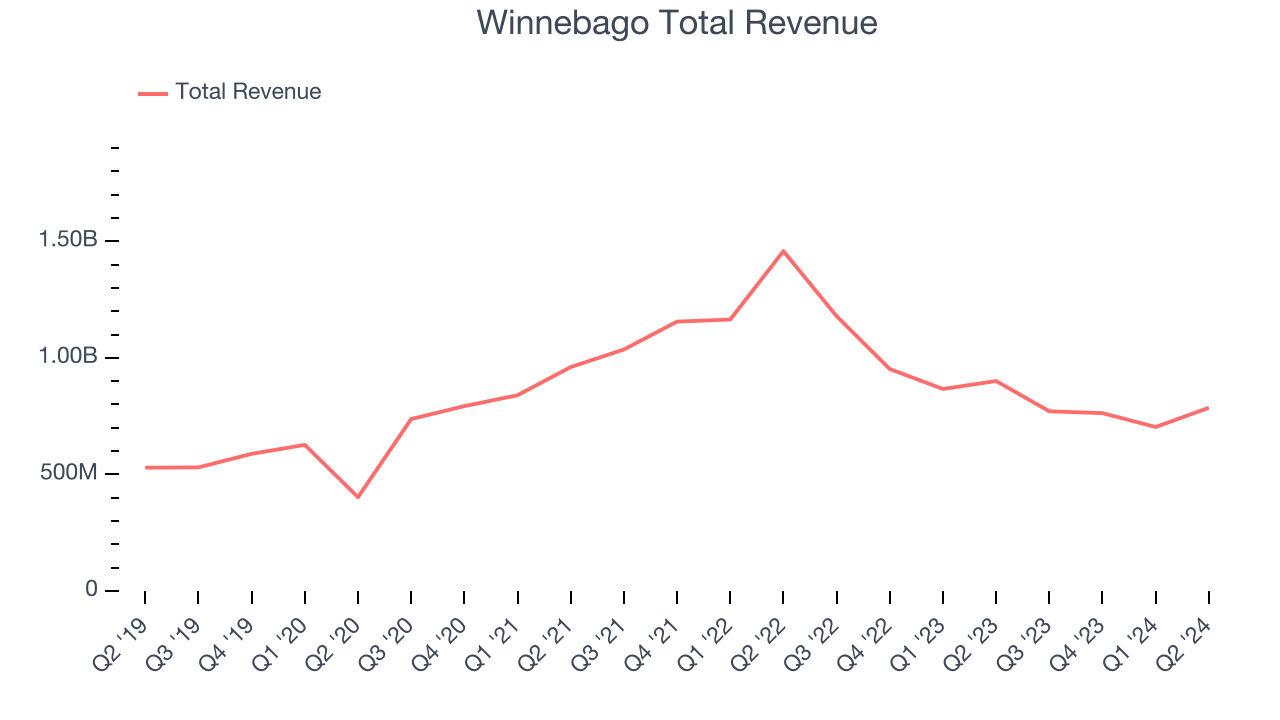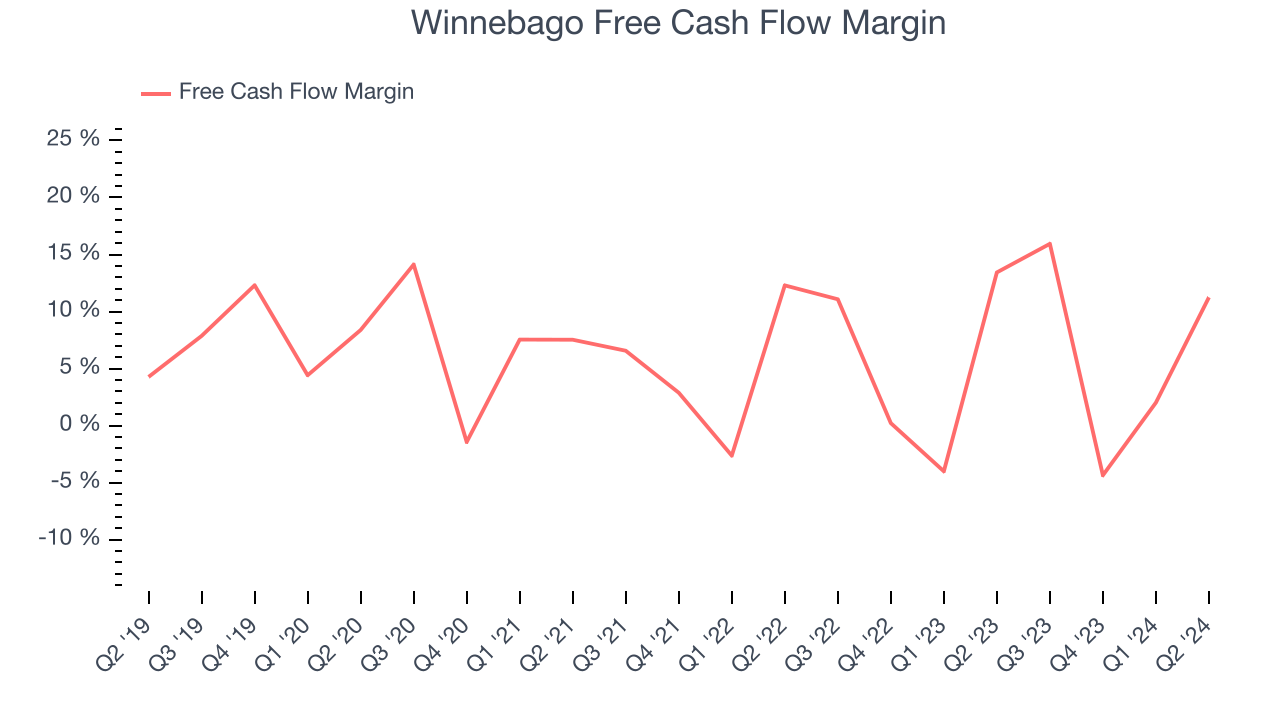RV Manufacturer Winnebago (NYSE:WGO) fell short of analysts' expectations in Q2 CY2024, with revenue down 12.7% year on year to $786 million. It made a non-GAAP profit of $1.13 per share, down from its profit of $2.13 per share in the same quarter last year.
Is now the time to buy Winnebago? Find out by accessing our full research report, it's free.
Winnebago (WGO) Q2 CY2024 Highlights:
- Revenue: $786 million vs analyst estimates of $797.6 million (1.5% miss)
- EPS (non-GAAP): $1.13 vs analyst expectations of $1.31 (14% miss)
- Gross Margin (GAAP): 15%, down from 16.8% in the same quarter last year
- Free Cash Flow of $88.4 million, up from $14.2 million in the previous quarter
- Market Capitalization: $1.66 billion
“While outdoor industry market conditions remain challenged given inconsistent retail patterns and sustained dealer discipline relative to field inventory levels, we are generally pleased with the resiliency of our portfolio, as our teams balance the pursuit of long-term share, profitability and customer satisfaction across our premium brands,” said Michael Happe, President and Chief Executive Officer.
Created to provide high-quality, affordable RVs to the post-war American family, Winnebago (NYSE:WGO) is a manufacturer of recreational vehicles, providing a range of motorhomes, travel trailers, and fifth-wheel products for outdoor and adventure lifestyles.
Automobile Manufacturers
Much capital investment and technical know-how are needed to manufacture functional, safe, and aesthetically pleasing automobiles for the mass market. Barriers to entry are therefore high, and auto manufacturers with economies of scale can boast strong economic moats. However, this doesn’t insulate them from new entrants, as electric vehicles (EVs) have entered the market and are upending it. This has forced established manufacturers to not only contend with emerging EV-first competitors but also decide how much they want to invest in these disruptive technologies, which will likely cannibalize their legacy offerings.
Sales Growth
A company’s long-term performance can give signals about its business quality. Even a bad business can shine for one or two quarters, but a top-tier one tends to grow for years. Over the last five years, Winnebago grew its sales at a decent 8.7% compounded annual growth rate. This shows Winnebago was successful in expanding its business, a useful starting point for our quality assessment. 
We at StockStory place the most emphasis on long-term growth, but within industrials, a stretched historical view may miss cycles, industry trends, or a company capitalizing on catalysts such as a new contract win or a successful product line. Winnebago's recent history marks a sharp pivot from its five-year trend as its revenue has shown annualized declines of 20.8% over the last two years. Winnebago isn't alone in its struggles as the Automobile Manufacturers industry experienced a cyclical downturn, with many similar businesses seeing lower sales at this time.
We can better understand the company's revenue dynamics by analyzing its most important segments, Motorhomes and Towables, which are 38% and 49.1% of revenue. Over the last two years, Winnebago's Motorhomes revenue (homes on wheels) averaged 13% year-on-year declines while its Towables revenue (non-motorized vehicles) averaged 26.2% declines.
This quarter, Winnebago missed Wall Street's estimates and reported a rather uninspiring 12.7% year-on-year revenue decline, generating $786 million of revenue. Looking ahead, Wall Street expects sales to grow 13.2% over the next 12 months, an acceleration from this quarter.
When a company has more cash than it knows what to do with, buying back its own shares can make a lot of sense–as long as the price is right. Luckily, we’ve found one, a low-priced stock that is gushing free cash flow AND buying back shares. Click here to claim your Special Free Report on a fallen angel growth story that is already recovering from a setback.
Cash Is King
Although earnings are undoubtedly valuable for assessing company performance, we believe cash is king because you can't use accounting profits to pay the bills.
Winnebago has shown decent cash profitability, giving it some flexibility to reinvest. The company's free cash flow margin averaged 6.2% over the last five years, slightly better than the broader industrials sector.
Taking a step back, we can see that Winnebago's margin dropped by 1.8 percentage points during that time. Winnebago's historical free cash flow profile was attractive, but shareholders are surely hoping for its trend to reverse.

Winnebago's free cash flow clocked in at $88.4 million in Q2, equivalent to a 11.2% margin. The company's margin regressed as it was 2.2 percentage points lower than in the same quarter last year, but we wouldn't put too much weight on it because a business's working capital needs can be seasonal, causing quarter-to-quarter swings.
Key Takeaways from Winnebago's Q2 Results
We struggled to find many strong positives in these results. Its operating margin missed and its EPS fell short of Wall Street's estimates. Overall, the results could have been better. The company is down 1.2% on the results and currently trades at $56.01 per share.
Winnebago may have had a tough quarter, but does that actually create an opportunity to invest right now? When making that decision, it's important to consider its valuation, business qualities, as well as what has happened in the latest quarter. We cover that in our actionable full research report which you can read here, it's free.
